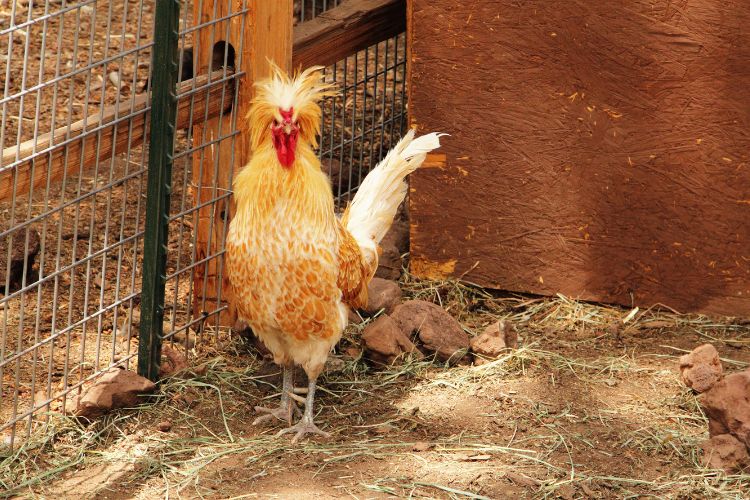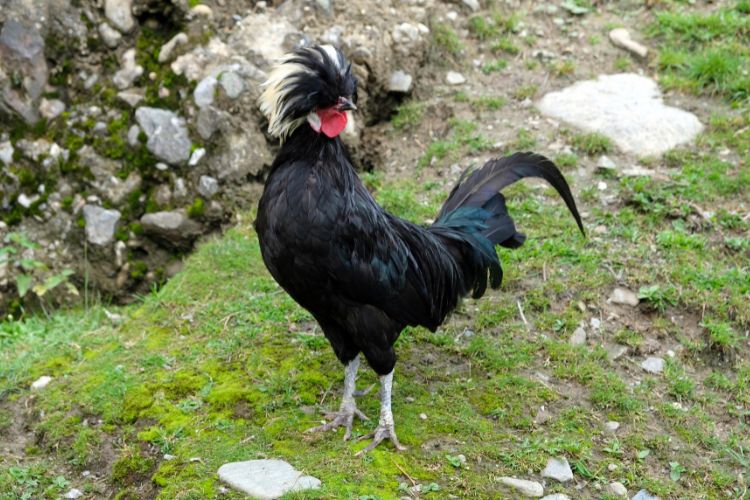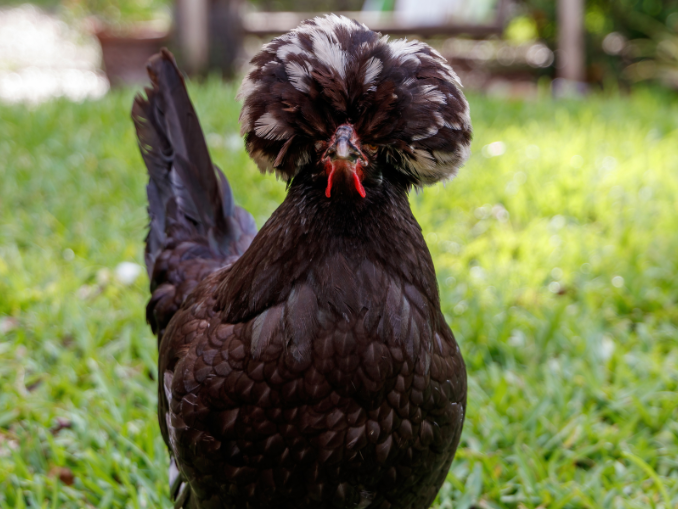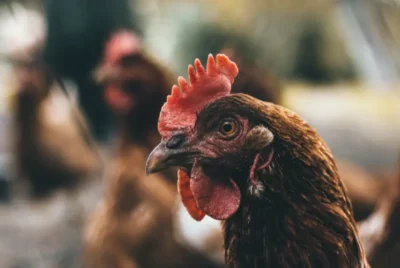Polish Chicken Breeds: Discovering Their Unique Characteristics

Diving into the world of Polish chickens is like opening a book full of surprises. These chickens are not just any ordinary birds; they have fancy feather hats that make them look like they’re always dressed for a party! But, caring for them is more than just admiring their unique style.
This article is all about getting to know these special chickens better. We’ll explore what makes them so cool and also talk about the extra attention they need because of their fancy feathers. Whether you’re thinking about adding them to your backyard flock or just curious, we’ll help you understand both the fun and the challenges of having Polish chickens around.
Quick Overview of Polish Chickens
- Distinctive Feature: Large, voluminous crest of feathers on their heads
- Size: Medium; hens weigh around 4.5-5.5 pounds, and roosters weigh 6-6.5 pounds
- Egg Production: Moderate; can lay about 200 white eggs per year
- Egg Color: White
- Temperament: Generally friendly, can be skittish due to limited vision from their crest
- Color Varieties: Includes white, black, blue, and buff, often with laced patterns
- Use: Mainly kept for ornamental purposes and egg production
- Lifespan: 7-8 years, depending on care and environment
- Care Needs: Requires regular grooming to maintain feather health and prevent vision obstruction; sensitive to cold because of large combs and crests
- Good For: Backyard flocks, show birds, and pets due to their unique appearance and relatively good egg laying
Origins of Polish Chickens
Polish chickens, known for their distinctive crests of feathers around their heads, have origins that are somewhat mysterious and not entirely linked to Poland as their name might suggest.
The breed is actually believed to have originated in the Netherlands or may have come from the Mediterranean area. Historical records suggest that these birds were first mentioned in the 16th century, and they became popular across Europe for their unique appearance and for being good egg layers.
The name “Polish” is thought to be a misinterpretation or could have been derived from the Polish word for “head,” referring to their notable head feathers, rather than the country of Poland.
Over time, After the breed Leghorn Chickens became famous, Polish chickens were selectively bred for their ornamental features and recognized by the American poultry association making them a favorite in poultry shows and as pets.
Distinctive Physical Characteristics

Polish chickens, known for their unique appearance and showy plumage, are a distinctive breed that stands out in the poultry world.
Here are some of their most notable physical characteristics:
- Crest of Feathers: The most distinguishing feature of Polish chickens is their large, poufy crest of feathers on top of their head, which often covers their eyes. This crest gives them a striking and somewhat comical appearance.
- V-Shaped Comb: Unlike the more common single or rose combs seen in other chicken breeds, Polish chickens have a small, V-shaped comb.
- Beard and Muffs: Many Polish chickens also sport a beard and muffs, which are extra tufts of feathers around the face and under the beak, enhancing their distinctive appearance.
- Bright and Varied Colors: Polish chickens come in a variety of colors and patterns, including white, black, blue, and splash. Some have laced patterns on their feathers, which adds to their visual appeal.
- Slender Body: They have a relatively slender body compared to other chicken breeds, with a more upright posture.
- Feathered Legs: Some varieties have slight feathering on their legs, though this is less pronounced than in breeds like the Cochin or Brahma.
- Size: They are generally a medium-sized chicken breed, with rooster weighing around 6 pounds and roosters about 4.5 pounds.
- Eyes: The feather crest can obscure their vision, which makes them appear more skittish and can affect their behavior.
How to Tell if a Polish Chicken is a Rooster
To determine if a Polish chicken is a rooster, look for larger, more pronounced combs and wattles, which are typically brighter in color. Roosters often have longer, more pointed hackle (neck) and saddle (back) feathers, and their tail feathers are typically longer and more curved compared to hens.
Additionally, roosters are generally larger and more boldly colored than hens. The behavior can also be a clue; roosters are more likely to exhibit territorial behavior, such as crowing and guarding the flock.
Color Varieties of Polish Breed
- White Crested Black Polish: Known for their striking contrast, these birds have a bold black body and a vivid white crest, making them stand out in any flock. The white crested blue polish is also available for this variety.
- Buff Laced Polish: These have a beautiful golden color with each feather delicately outlined in a darker shade, creating a laced effect.
- Silver Laced Polish: Similar in pattern to the Buff Laced but with a stunning silver base color and black lacing on each feather.
- Gold Laced Polish: These birds feature a rich golden base color with black lacing, offering a vibrant appearance.
- White Polish: Pure white all over, including their crest, these birds offer a clean and elegant look.
- Black Polish: They are entirely black, including their feather crest, giving them a sleek appearance.
- Blue Polish: Sporting a rare blue-gray color, these birds are less commonly found but highly prized for their unique feather color.
- Splash Polish: Splash refers to a mottled pattern of colors, typically white with spots of black and gray, resulting in a “splashed” paint effect.
Read also: The Polish Frizzle Chicken – A Guide to the Fun Chicken Breed
Temperament and Behavior
Polish chickens have a calm, docile temperament, making them excellent pets and ornamental birds. They are generally friendly and can be quite tame, especially if handled regularly from a young age. However, their vision is often impaired by the large crest of feathers on their heads, which can make them more skittish or easily startled than other breeds.
Despite this, they usually get along well with other chicken breeds in a mixed flock, though their limited vision can sometimes put them at a disadvantage, particularly in establishing pecking order or avoiding more aggressive birds.
Owners should ensure Polish chickens have a safe, secure environment and may need to pay extra attention to protecting them from predators due to their reduced awareness. Regular grooming may also be necessary to keep their crest feathers clean and prevent vision impairment.
Polish Chicken Hens Egg Laying Production
Polish hens are moderate egg layers, typically producing about 2 to 4 eggs per week, or around 100 to 200 eggs per year. Their eggs are usually small to medium in size and white in color.
While they are not the most prolific egg layers than to some other breeds, their unique appearance and friendly nature often make them a favorite among poultry enthusiasts. Egg production of a Polish hen can vary depending on diet, environment, and overall health of the hen.
Care and Husbandry

Housing Needs
Polish chickens require a secure, well-ventilated coop to protect them from predators and harsh weather, due to their limited vision caused by their feathered crest. The coop should be spacious enough to prevent overcrowding and reduce stress. Provide perches for roosting and nest boxes for laying eggs. Their enclosure should include a fenced outdoor area where they can forage, dust bathe, and exercise safely.
Diet and Nutrition
Feed your Polish chickens a balanced diet of quality poultry feed suitable for their life stage (chick starter, grower, or layer feed). Supplement their diet with grains, vegetables, and occasional protein sources like mealworms for variety and additional nutrients. Ensure constant access to fresh, clean water. Adjust feed and monitor weight to maintain optimal health and egg production.
Health Concerns and Preventive Measures
Polish chickens are susceptible to the same health issues as other chicken breeds, including parasites, respiratory problems, and infections. Their crested feathers can also attract mites and lice. Regular health checks, vaccinations (where applicable), and parasite control are crucial. Keep their coop and run clean and dry to prevent diseases.
Grooming and Maintenance of the Feathered Crest
The feathered crest requires special attention to keep it clean and dry, preventing vision impairment and infections. Trim feathers around their eyes if necessary to improve visibility. Check regularly for dirt or parasites, and gently clean the crest with a damp cloth if it becomes soiled.
During wet weather, provide a dry shelter to prevent the crest from getting wet and causing health issues.
Polish Chickens in Culture and Society
Role in Backyard Poultry and Small Farms
In backyard poultry and small farm settings, Polish chickens are often kept for their ornamental value rather than for meat or egg production due to their striking appearance and friendly nature. They add aesthetic appeal and personality to a flock, making them popular among hobbyists and those interested in preserving unique or rare breeds. Their relatively calm temperament makes them suitable for family settings where interaction with poultry is desired.
Contributions to Genetic Diversity and Conservation
Polish chickens contribute significantly to the genetic diversity of domestic poultry. Their unique traits, such as the large crest of feathers on their heads and their variety of colors and patterns, make them valuable for breeding programs aimed at preserving genetic diversity within poultry species.
Conservation of breeds like the Polish chicken is important for maintaining a wide genetic pool, which can be crucial for the future of agriculture and for breeding programs aiming to introduce or maintain desirable traits in poultry.
Polish Chickens in Shows and Competitions
Polish chickens are a favorite in poultry shows and competitions because of their distinctive appearance and variety of colors and patterns. Their unique crest and striking plumage make them stand out, drawing the attention of judges and spectators alike.
Enthusiasts often breed Polish chickens specifically for show, focusing on the perfection of their physical characteristics according to breed standards. Success in shows not only brings prestige to the breeders but also helps to maintain interest in the breed, promoting its preservation and continued popularity.
Challenges and Considerations for this Chicken Breed
Breeding Challenges Due to Physical Characteristics
The prominent crest of feathers on Polish chickens can cause several breeding challenges. Firstly, the crest can impair vision, making mating behaviors more difficult as the birds may not see each other properly. This can lead to lower fertility rates.
Additionally, the large crests are subject to getting wet or dirty, which can lead to skin infections or other health issues. Breeding for larger crests, a desired trait in show birds, can exacerbate these issues.
Genetic issues can also arise from selective breeding practices focused on enhancing specific physical traits like crest size.
Considerations for Keeping Polish Chickens in Different Climates
Polish chickens can be sensitive to extreme weather conditions due to their unique feathering. In very hot climates, their dense crest can trap heat, leading to overheating. Adequate shade, ventilation, and access to water are crucial in these conditions.
Conversely, in wet or cold weather, their crests can become wet and freeze, posing a risk of hypothermia or frostbite. Coop modifications to ensure a dry and warm environment are essential in colder regions. The crest may also need regular trimming to prevent it from becoming matted or ice-laden.
Predation and Safety Concerns
The crest of Polish chickens not only affects their vision but also makes them more vulnerable to predators. Their limited vision hampers their ability to detect threats quickly, making them easy targets for predators. Secure housing is critical to protect them from predation.
This includes robust fencing, secure nighttime enclosures, and possibly guardian animals for the flock. Owners should also be mindful of the pecking order within the flock, as Polish chickens may be bullied by other breeds due to their impaired vision and submissive nature.

Final Words
Polish chickens are a delightful breed that adds flair and personality to any backyard or farm. Their appearance, combined with their friendly nature, makes them a favorite among poultry enthusiasts.
By understanding and catering to their needs, keepers can ensure these beautiful birds thrive, continuing to enchant and captivate with their striking presence. Whether for show, companionship, or the simple pleasure of their company, Polish chickens offer a rewarding experience for those willing to embrace their distinctive characteristics.




